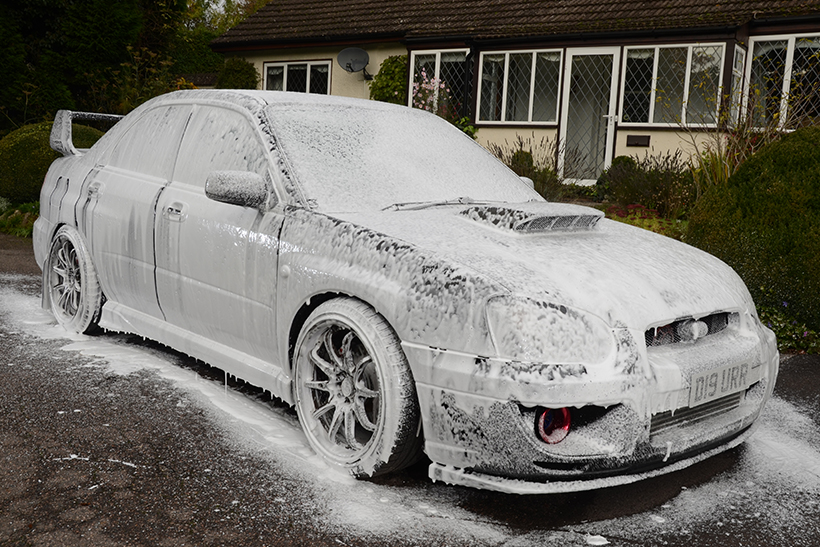What’s the best way to protect your car’s paint and bodywork in winter? Find out with our winter detailing guide.
It seems to be getting colder and darker every minute, so it must be about time for those essential FC tips to make motoring in the harshest of seasons a tad less soul-destroying. Now, you can check out our Top Winter Car Care Tips for some guidance, but first we need to deal with the most important part of winter car preparation – protecting your paintwork.
There’s all sorts of myths surrounding winter detailing, all the usual guff like having to apply 16 coats of hard wax, heating your water to exactly 36˚ Celsius and washing your car every 3.7 seconds. But what’s the whole truth? To get the answers we had to draft in a pro, and it just so happens that pro is Dom Colbeck, the main man at Dodo Juice.
If you’re looking to get your car ready for the big freeze – and you should be, right about now – here’s how it’s done by the experts…
Winter Detailing Guide

1. PRE-WASH YOUR CAR
We all know winter is a right bugger for dirt, grit and salt on your paintwork. But before you go hitting it with the bucket and wash mitt it’s vitally important to, at the very least, get the car wet first.
Most scratches and swirls are inflicted by contact washing and that’s because you’re essentially pushing all the heavy grime around with your mitt. A decent pre-wash procedure should vastly reduce the risk of scratching the surface. You’re actually better off leaving your car dirty over the winter than not pre-washing. It’s that simple.
DO IT…
If you’re in a fix, a bucket of clean water or even a watering can is better than nothing. That said, investing in a pressure washer will always be your best bet, because the water pressure alone will help remove the dirt. It’s also a good idea to utilise a TFR (Traffic Film Remover) to chemically dissolve the grime, especially on the lower areas of the car which attract the most heavy soiling.
Using a snow foam in conjunction with your pressure washer and a foam lance is also a great way of lifting and removing the muck without touching the surface. Work from the bottom of the car upwards, so, as the foam runs off, it’s always replenished by the product above it. Maximum dwell time means more dissolving of dirt, so the thicker the foam you get on there the better.

2. WASH AND DRY YOUR CAR
Now you’ve done a pre-wash for the heavy stuff, it’s time for a contact wash to get rid of the remaining grime. The most important thing here is to use a good quality mitt and two buckets – one for clean water and one to squeeze out your dirty water. Some of the flasher ‘professional’ buckets out there come with integrated grit guards, which are good, but by far the best solution is to use two separate buckets, even if they’re cheap Poundland jobs.
When it comes to drying, the humble microfibre cloth is your friend. Use these instead of a traditional chamois leather because they have pile for any errant particles of dirt to escape into – a chamois could trap it and drag it across your paint.
DO IT…
Make sure you’re using a decent quality car shampoo, preferably one that doesn’t contain silicone or loads of shining agents – you’ll only end up removing these later.
Don’t be tempted to bung in a load of washing up liquid either. Unlike proper shampoo it often contains salt and can do more damage to your paint than you think, especially around stone chips and the like. Use warm water in your ‘clean’ bucket because cold water is far less effective at dissolving dirt on contact – plus no one likes freezing their hands off while they work. Start at the top of the car and work your way down, using plenty of your soapy water. If you need to change the water half way through then do it – it only takes a minute and can make all the difference.
When you’re wiping down the car with your microfibre, the use of a drying aid or even a quick detailer on each panel is always a good call. These will help lubricate any leftover dirt. Lovely jubbly.

3. POLISH AND WIPE YOUR CAR
The next stage is surface preparation. This process is important, to make sure the paint is ready to accept those protective layers and consists of further decontamination (with a clay bar and so forth), a polish and solvent wipe down.
Some say an in-depth machine polish is the way to go, but in reality that’s completely optional. In all honesty you might as well save all that effort for the spring time – your car is going to get dirty over winter whether you like it or not and never going to look as good as it could. Save the effort, save a micron or two of Clear-Coat and move on to a minor clay session and a quick hand polish.
Next – and perhaps the most important part – is the wipe down phase. As I said, many shampoos contain silicone and oils that level the optical finish (or, to us mere mortals, give a nice glossy appearance). These may be great for maintenance washes, but they’re not so clever when you’ll be trying to get a sealant to stick to the paint later. Wiping down the whole car with a solvent quickly dissolves these oils in preparation for the protection stage.
DO IT…
The polishing bit is simple enough, but what sort of solvent should you use? Well, although you can technically slap on some white spirit, panel wipe or even vodka, the best option is a dedicated tar remover or alcohol-based glass cleaner. What your looking for is an IPA (Isopropyl Alcohol) concentration of 20-50 percent, no more.
Using a clean microfibre and your solvent, give the surface a good going over. By now it should be cleaner than a brain surgeon’s whistle.

4. PROTECT YOUR CAR’S PAINT
Now you have a paint surface free from dirt and oil it should offer perfect adhesion for LSP (Last Stage Protection) products. So now you can apply the layers that are gonna keep it nicely shite-shielded over winter.
A quality wax is of course better than no protection at all, but Dom suggests opting for a man-made paint-sealant or semi-synthetic hybrid wax if you can. There’s various reasons for this, but basically sealants tend to be harder wearing, after all you’ll be wanting it to last well into next year. Natural waxes are a type of sacrificial layer meaning they degrade more quickly over time and also tend to pick up dirt along the way. Sealants on the other hand are engineered at a molecular level to repel dirt. The chemically gifted guys in white coats will tell you that their molecules are arranged in a more regular, orderly fashion and this stops the dirt sticking. The molecules in natural waxes on the other hand are much more randomly structured enabling the muck to penetrate and cling. The structural differences are similar to the ones between plywood and chipboard, only a lot smaller.
DO IT…
Apply your sealant panel by panel, observing the instructions on the bottle. Buff off any residue on each panel with a clean microfiber before moving on to the next one. Make sure you don’t miss any parts out, and then do the whole lot again when it’s dry to build up another layer. Unlike waxes, many sealants are safe for use on side glass and trim too. Oh and don’t forget your wheels while you’re at it.

5. MAINTAIN IT
Believe it or not, the secret for perfect winter maintenance is not to clean your car too much. Now I realise that’s a strange thing for a firm that sells detailing products to say, but unless you have any exposed metal or an older car which presents a rust risk, that really is the truth. Dom says, “If in doubt, leave it dirty, or you could do more harm than good.” At most you should halve the frequency of washing. Once a month is sufficient.
DO IT…
Pre-washing is essential and so is using a snow foam and shampoo that won’t strip your sealant. Don’t forget your paint is thoroughly protected and any dirt is now sitting on top of that layer protecting it even more. Chances are it’ll slide right off with a quick once over too, so there’s no need to go batshit with the regime. Besides, that’s why you did all that preparation in the first place, right?
Pre-wash, wash and dry your car as normal, but don’t bother with any polishing or solvent wiping. If you’re feeling flash you can top up the sealant with another layer, but that’s it. Just enjoy the low maintenance motoring until spring!
WHAT ABOUT VINYL CAR WRAPS?
They may look like paint but wraps are little more than big stickers, so it pays to be extra careful when prepping for winter. First be wary of any joins or edges when you’re using your pressure washer – you don’t want to lift these away from the car.
Obviously, you’ll need to exercise the same level of caution during contact washing. Wraps should be dried in the same way as paint, but avoid quick detailers and drying agents on matt vinyls. They can’t really be polished either, but a good wipe down with a mild solvent is always a good finisher. Look for a product with nothing more than around 20-percent IPA though. Harsh solvents will inevitably soften the surface making it a dirt magnet. For this reason too, the vast majority of waxes can’t be used on wraps because of their high solvent content. As a rule of thumb, if you can smell the solvent you shouldn’t use the product on your gloss wrap – obviously matt wraps can’t be waxed at all.
When it comes to sealants, technically water-based products can be used to good effect, but then good quality vinyl is engineered to fend off grime in the first place. The vast majority of the time a simple case of pre-washing, washing and drying will do the job. If you treat your wrap the same as very soft paint you shouldn’t go too far wrong.

AND WHEN YOU’RE ALL DONE…
If it’s gonna drop below freezing, get yourself a big bag of salt and use it on your drive, path or the road when you’ve finished your washing. All that rinse water coming off your car will freeze overnight causing a lovely, slippery sheet of ice come morning. It may save you 30 seconds not doing this, but that’ll come as no comfort when some old lady inevitably goes arse over tit or you end up crashing into your house. Just grab some at Tesco, do your best Jamie Oliver seasoning impression, and you’ll sleep better. Probably…







